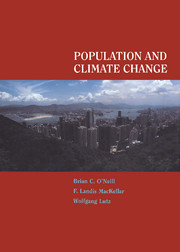Book contents
- Frontmatter
- Contents
- Foreword
- Preface
- Authors and Contributors
- Acknowledgments
- PART I
- PART II
- 4 Population and Greenhouse Gas Emissions
- 5 Population and Adaptation: Agriculture, Health, and Environmental Security
- 6 Population and Climate Change: Policy Implications
- Appendix I Fertility and Mortality Assumptions for IIASA Population Projections
- Appendix II Household-level Economies of Scale in Energy Consumption
- Appendix III Population in Major Climate Change Assessment Models
- References
- Index
6 - Population and Climate Change: Policy Implications
Published online by Cambridge University Press: 23 December 2009
- Frontmatter
- Contents
- Foreword
- Preface
- Authors and Contributors
- Acknowledgments
- PART I
- PART II
- 4 Population and Greenhouse Gas Emissions
- 5 Population and Adaptation: Agriculture, Health, and Environmental Security
- 6 Population and Climate Change: Policy Implications
- Appendix I Fertility and Mortality Assumptions for IIASA Population Projections
- Appendix II Household-level Economies of Scale in Energy Consumption
- Appendix III Population in Major Climate Change Assessment Models
- References
- Index
Summary
While recent international agreements have recognized relationships between population and global environmental issues, none has translated these linkages into specific recommendations. On the environment side, Agenda 21, signed at the Earth Summit in 1992 and intended as a blueprint for sustainable development, recommends only that nations take demographic factors into account in the policymaking process. On the population side, the Programme of Action agreed to at the International Conference on Population and Development in Cairo in 1994 also discusses population–environment links, but does little more than repeat the language of Agenda 21.
One logical forum for analysis of relationships between population and climate change is the Intergovernmental Panel on Climate Change (IPCC), which is charged with assessing the science of climate change and its potential impacts, as well as formulating response strategies. Yet it has paid little attention to population. For example, the IPCC's most recent reports on mitigation and adaptation options (Watson et al., 1996; Bruce et al., 1996) evaluate a wide array of strategies but do not consider policies to slow population growth. There are likely a number of reasons for this omission, not least the tension between North and South over the relative contribution of population and consumption to environmental problems (Bongaarts et al., 1997).
In Chapters 4 and 5 we examined the role of population growth in generating greenhouse gas (GHG) emissions and its impact on the ability of societies to adapt to climate change. Chapter 4 concluded that under conditions of rapid demographic transition (lower fertility and lower mortality, resulting in slower population growth and an older population age structure) GHG emissions would be reduced relative to emissions in a baseline demographic scenario.
- Type
- Chapter
- Information
- Population and Climate Change , pp. 184 - 206Publisher: Cambridge University PressPrint publication year: 2000

